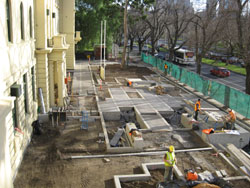resource library
Array

Raingardens during construction

2007 Yarra River Youth Conference: Students participate in the planting of one of the raingarden beds
Victorian College of the Arts raingardens
City of Melbourne
234 St Kilda Road, Southbank, Victoria | Map:
Published: 28 February 2013
Project Overview
The VCA raingardens is a unique, well-established and award winning project, recognised across the industry for its innovation and landmark design. In January 2007, the University of Melbourne embarked on a major upgrade and revitalisation project of the St Kilda Road frontage of the Victorian College of the Arts (VCA). The project was initiated by the University of Melbourne with a Community Water Grant, which was then supplemented by Melbourne Water funding and support.
The landscape features of the garden take into consideration the heritage listed frontage of the site, the need for pedestrian movement and the provision for the display of student art, while at the same time incorporating Water Sensitive Urban Design elements. Roof and pavement runoff (650m2) is captured and treated through seven inter-connected raingardens (covering an area of nearly 58m2) before discharge into the drainage system. Stormwater collection and conveyance elements are kept above-ground wherever possible. This allows for greater visibility of the treatment process and therefore increased community awareness. When required, original design elements such as stainless steel grates and spouts in the shape of an eel head convey stormwater underneath walkways to allow for pedestrian movement.
The garden claimed two landscape design awards at the 2008 AILA Victoria Project Awards and was highly commended at the Stormwater Industry Association annual awards in the same year.
Drivers and Objectives
Create a green urban space as an interface for the St Kilda Rd entrance to the VCA.
Develop community awareness and showcase a water sensitive landscape by making the stormwater treatment process as visible as possible.
Preserve the heritage listed site by:
- Ensuring the visual appearance of the site (including the façade and existing trees) would remain unchanged
- Minimising changes to permeability in the areas surrounding the two mature Kauri Pines located outside of the Elisabeth Murdoch Building (operating as the VCA's administrative building)
- Using material that is consistent with the existing urban landscape
Improve stormwater quality through the treatment of runoff from adjacent infrastructure.
Enhance pedestrian access and movement through the site, taking into account the access and function of existing buildings.
Ensure provision for permanent and temporary art installations.
Organisations
- City of Melbourne (Responsible Council and Project Manager)
- Victorian College of the Arts - The University of Melbourne (Site Owner and Maintenance Provider)
- Australian Government Water Fund - Community Water Grant (Funding Partner)
- Melbourne Water - Living Rivers Program (Funding Partner)
- Heritage Victoria (Referral Authority)
Project Outcomes
Student education: Students attending the 2007 Yarra River Youth Conference used the site as a demonstration and learning opportunity: After being taught the basic principles of a raingarden, they participated in the planting of one of the beds.
Reduction in stormwater pollutants reaching the lower Yarra River.
Increased community awareness of stormwater issues: The use of above ground stormwater collection and conveyance systems draws attention to the water cycle and the stormwater treatment provided through the raingardens.
Creation of a strong, artistic public space which provides an interface to the VCA and which is enjoyed by students as a place to relax, gather and enjoy works of art.Careful consideration of specific heritage and architecture elements through the choice of plants (indigenous, native cultivars and exotic species) and construction materials (bluestone and aggregate concrete).
The VCA project is a demonstration site for the implementation of a water sensitive landscape. It is a destination for many formal and informal industry WSUD tours and has stimulated knowledge sharing with peers.
Lessons Learnt
This project uses design elements to inform the visitor about the purpose and the working of the site. It shows that community awareness and education can be achieved by other means than interpretative signage.
Site management during construction was critical at this very busy location.
Tree protection zones need to be considered early on in the project and prior to starting the construction phase.
It is paramount to select your filter material carefully and to ensure that the delivered material corresponds to what you ordered. This project suffered some initial setbacks due to weed problems in the imported soils.
Connection to shallow stormwater drains can be challenging, and alternative design options, which might deviate from best practice, can be critical to the success of the project. In this instance the depth of the filter media had to be reduced.
To avoid losing seedlings in a drought event, it is recommended to use an ancillary irrigation system during the establishment phase of the plants in the garden beds and raingardens.
Ongoing maintenance of the system showed that plants in the raingardens suffered during longer periods without rain. Following a severe dry spell in 2006, 60% of the plants had to be replaced. This dramatically affects the amenity of this high-profile site.
The University of Melbourne is planning to extend the project further up the street as part of their campus masterplan, and the maintenance crew suggest the following enhancements for this extension:
- Ensure vegetation species are tolerant to longer dry periods (some of the species used in this project were more suited to wetland conditions)
- Insert a bit of water absorbent polymers around the rootzone when planting (the raingarden filter material promotes quick drainage and has a low moisture retention capacity)
- If possible, plan for a water storage area (e.g. underground tank) to be able to release the water in batches and reduce the length of dry spells
- Have a potable back-up system in place
- Ensure irrigation system exists for beds without stormwater inflow
Project Cost
Design: $120k
Construction: $300k
Maintenance: $7.5k - $10k per year (includes plant replacement, pruning and rubbish collection - excludes installation of an additional irrigation system and cost of water used in this system)
Timeframe
Concept Design: March-May 2007
Construction: May 2007
Planting: May 2007 (during the Melbourne Water Yarra River Youth Conference)
Contact
T 03 9679 7711
W clearwater.asn.au
